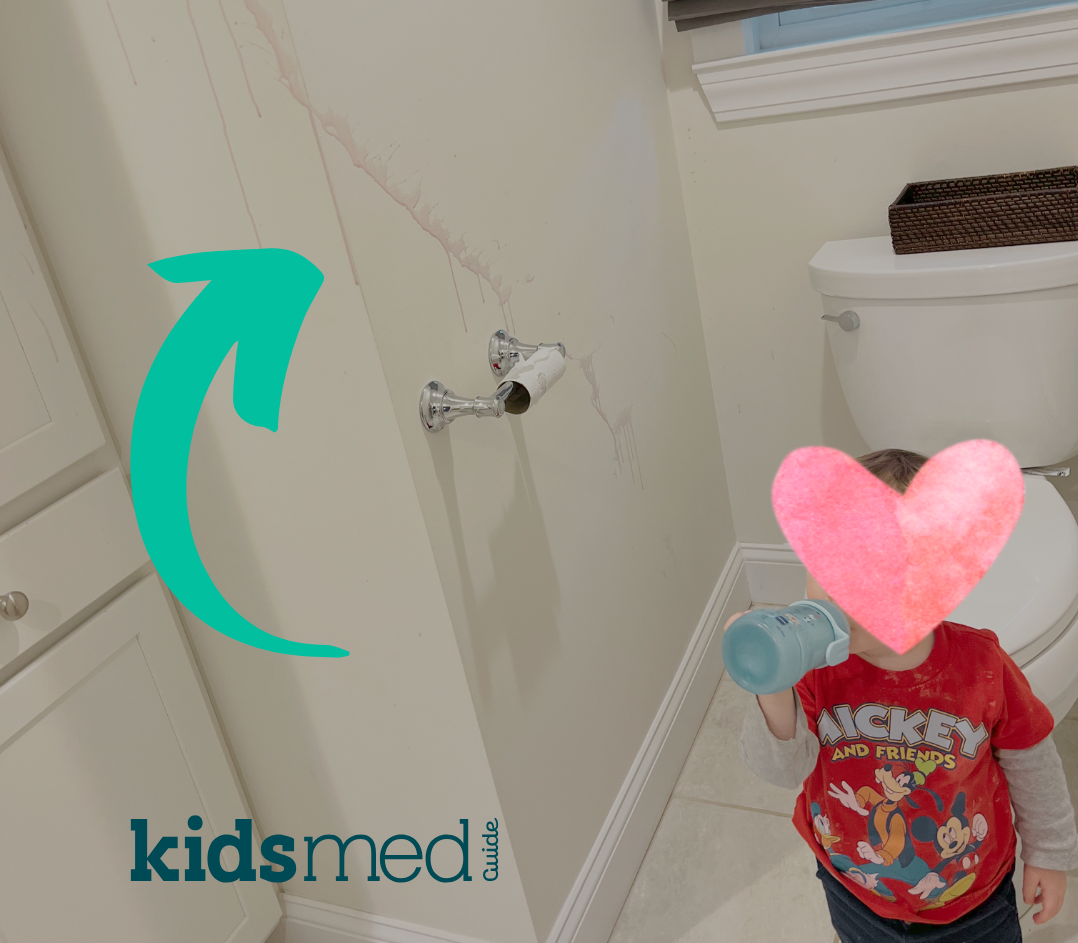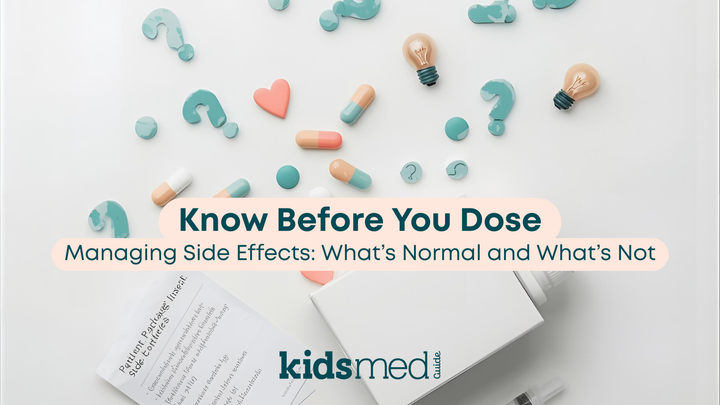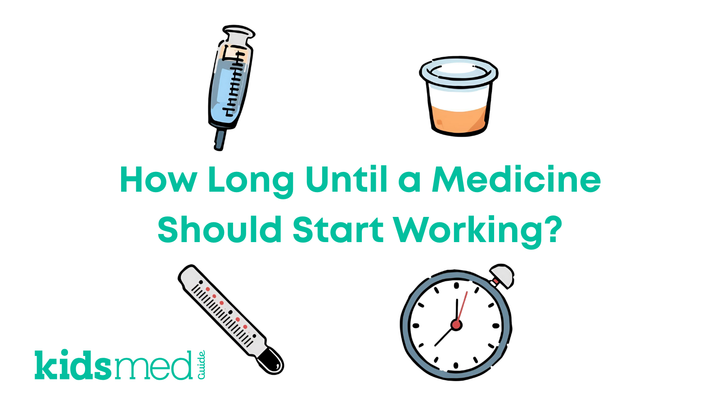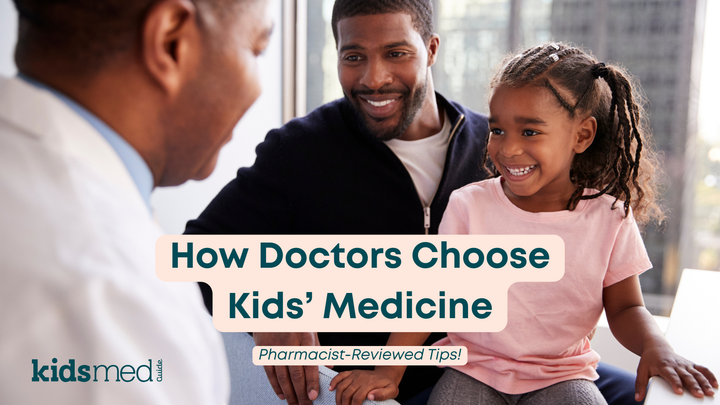How to Get Your Toddler to Take Yucky Medicine Without a Battle

I don’t like to brag, but I consider myself a bit of an expert at yucky medicine administration. I worked for years at a children’s hospital, where I learned all the tricks of the trade from the superstar pediatric nurses. Between nursing and pharmacy, we were usually able to come up with a solution that even the most discerning child would tolerate.
Once I had my own kids and had to start tricking them into taking medicine, I still considered myself an expert at this; however, I gained a newfound respect for the nurses who were the ones actually giving the medicine. It’s definitely easier on the pharmacy side of the phone!
Read on for my RPh/RN-approved medication administration tips that should help doses go down smoothly… or at least prevent World War 3 from occurring in your kitchen.
Be Patient
This is hard for me. I’m not a patient person by nature. Parenting has, of course, expanded my abilities to be patient, but sometimes it's still hard for me not to shriek, “For Pete’s sake, just swallow this medicine!” after the 5th failed attempt. Just know if medicine tastes gross, your kid will battle you, you’ll lose your patience, and it’s normal to be frustrated. Try to stay zen.
Use a Dosing Syringe, Not a Cup
Properly marked dosing cups are fine for medicine that your child will accept. However, for small kids—babies, young toddlers, and so on—an oral syringe is the best option.
Dosing syringes help ensure that the full amount goes into your child’s mouth—and past their taste buds. The nurses taught me to aim for the back inside of the cheek and squirt slowly, bit by bit. It takes a while, but kids are much more likely to swallow the medicine instead of spitting it out this way.
Use caution to aim for the back of the cheek or back of the tongue, never directly down the back of their throat. They could choke or aspirate on the medication.
Distractions
Distract them with anything possible—funny faces, songs, poop jokes, Ms. Rachel, the ceiling fan on high... literally anything you know will captivate their attention! If your kid doesn’t get screen time, now is the time to whip out your iPhone and break the rules. Cocomelon for the win!
Try the Flavor Trick
Ask your friendly neighborhood pharmacist if the medication can be flavored. Pharmacies often offer choices like bubblegum, grape, or strawberry to mask the bitterness. Please be patient with this. As we are all likely aware, retail pharmacists are often overworked and short on time, and it may take them a few minutes to fulfill this request.
It’s not as simple as just adding a few drops of your child’s favorite flavor; they have to refer to a recipe card to check for compatibility between your medication and the flavoring ingredients. Medications that are bitter, sour, minty, etc., may require different masking agents, and the inactive ingredients, along with the way the liquid is suspended in solution, may also be important.
Chase It (Strategically)
Give your child a ‘chaser’—such as a sip of juice, a popsicle, or applesauce—immediately after administering the medicine. Some parents even swear by a mini chocolate chip! I’ve also heard nurses say that chocolate syrup works well. The more enticing the reward, the better!
Certain medications should be taken without food. Refer to the package insert or consult your pharmacist. If that’s the case, don’t use this method or offer water only. Also, keep in mind that some medications are not compatible with certain food types, like dairy.
Cool it Down
If the package labeling or your pharmacist indicates it’s safe, refrigerating liquid medicine can help mask the taste. Cold numbs the taste buds slightly, making bitter flavors easier to tolerate. Think about that really gross glucose drink that pregnant people have to drink during their diabetes screen. Tastes better cold, right?
Reward, Don’t Bribe
A sticker chart or a special toy can go a long way when used consistently. Just be careful not to let rewards turn into bribes. Make it part of the routine: medicine, then praise, then reward. And in general, kids thrive with routines. If they know what to expect, it might be easier.
My toddler sees right through this guise and laughs in my face when I suggest a sticker chart or a trip to the dollar store. But maybe your toddler will fall for it!
Mix With Caution
Use a lot of caution before mixing medicine into a full bottle or cup of food—you may not know how much your child actually consumes. If your child only drinks 80% of the liquid in the cup, you can’t equate that to 80% of the dose. There’s no way to determine what they received.
Instead, ask your pharmacist if the med can be mixed with a small spoonful of pudding or yogurt. (Always ask—some meds can’t be mixed safely, need to be on an empty stomach, or can’t be mixed with certain food types like dairy products or acidic things.)
Use the Buddy System
Let a favorite stuffed animal ‘take’ the medicine first. Then, your child can be brave and go next. Role-playing can help reduce anxiety and resistance. Playing doctor or nurse addresses many medical anxiety issues! If you have a doctor kit at home, bring it out and discuss why the dolls and stuffies need their medicine.
Let Your Child Be in Control
For older toddlers and kids, you can let them hold the syringe and decide how much to drink at a time and how fast. Combine this with other strategies, like rewards. Use caution with this—if medication is very expensive or dangerous, you will want to be more judicious.
However, for a pre-measured dose of Tylenol that you’ve checked, I’d feel comfortable allowing the child to slowly squirt the syringe into their own mouth at their own pace, under supervision, of course!
I say this with a grain of salt and also while laughing at myself. Please enjoy this picture of the damage done to my walls when I let my 2-year-old "hold" the medication oral syringe. Purple everywhere.

Explain to Your Child Why
For older kids, likely around ages 6 to 8 and above, try explaining patiently why they need the medicine and why they should be brave enough to take it despite the taste. You may be surprised at what an honest conversation can achieve, rather than just trying to force it.
Know When to Call for Help
If your child consistently refuses or spits out medication, call your pediatrician or pharmacist. There may be an alternative form (chewable, dissolvable, rectal, etc.) or a different medication altogether. You might find that an appropriate dose can be given in tablet form, and that tablet could be small! Your kiddo might surprise you and swallow the tablet without any issues.
Sometimes, pharmacists can get crafty and suggest unconventional methods, like crushing a tablet or opening a capsule and mixing the powder with a spoonful of applesauce. It’s not always an option, but it’s worth asking!
End With Lots of Rewards and Praise!
Honesty isn't always the best policy here, folks. Even if your child cries like their pet just died, hug them and tell them good job and how proud you are of them afterward. Save the eye roll for when they can’t see you.
A Few Extra Safety Tips:
Never force it. Your child could choke or vomit.
Always use a measuring device from the pharmacy with proper milliliter (mL) markings. No kitchen spoons! Pro tip: pharmacists are usually happy to provide extras free of charge.
Pay attention to the storage requirements, temperature requirements, and expiration dates.
NEVER refer to medicine as candy or a treat. Emphasize early on that medicine must be used safely and can only be given to children by their parents or caregivers. Additionally, teach them that they should never put anything in their mouths without asking first.
Related:
What to Do When Your Kid Spits Out Their Antibiotics
The following references were used to compile this information:
Durani, Y. & MD. (n.d.). Helping Kids Take Medicine. Retrieved June 11, 2025, from https://kidshealth.org/en/parents/take-medicine.html
Symptomviewer. (2017, June 24). HealthyChildren.Org. https://www.healthychildren.org/English/tips-tools/symptom-checker/Pages/symptomviewer.aspx?symptom=Medicine+-+Refusal+to+Take



